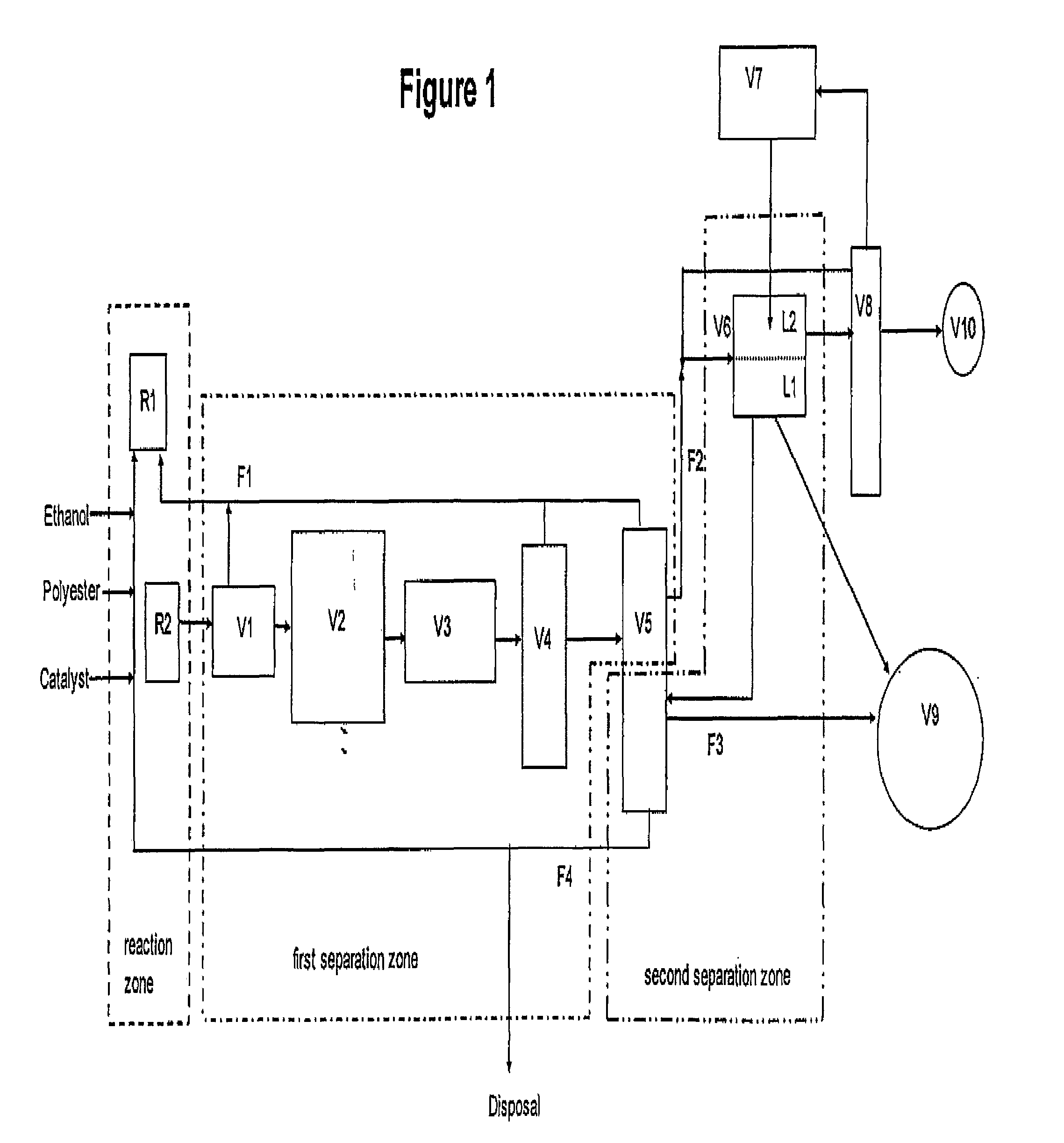Ethanolysis of PET to Form DET and Oxidation Thereof
a technology of ethanolysis and det, which is applied in the preparation of carboxylic compounds, organic chemistry, and separation/purification of carboxylic acid esters, etc. it can solve the problems of waste unsuitable for many recycling processes, limit the utility of such a blending process, and increase the difficulty of recycling. , to achieve the effect of simplifying handling and processing
- Summary
- Abstract
- Description
- Claims
- Application Information
AI Technical Summary
Benefits of technology
Problems solved by technology
Method used
Image
Examples
example 1
[0128]300 g of PET flake of the type indicated in Table 1 was reacted with ethanol at an ethanol:PET weight ratio of 3:1 in accordance with the above procedure. The ethanol had a water content of 0.0734 wt %. No external catalyst was added. Both mixed flake and the clean clear flake were obtained through NAPCOR, the National Association for PET Container Resources The mixed flake contained about 55 wt % brown flake with the rest being primarily green, amber and clear PET flake. The virgin bottle resin was obtained from Wellman Inc. as product number 61802. The theoretical maximum percentages of DET and ethylene glycol in the reaction mixture were 28.86 wt % and 8.06 wt %, respectively.
TABLE 1DET and Ethylene Glycol Recovered using Various PET FlakeDETEthyleneRun #Flake UsedRecoveredGlycol Recovered1Mixed22.3wt %6.25wt %2Mixed25.2wt %6.54wt %3Virgin Bottle Resin0.53wt %0.21wt %4Clean Clear1.06wt %0.45wt %5Brown24.16wt %5.41wt %6Amber0.80wt %0.37wt %7Mixed w / o Brown2.8wt %0.51wt %8Cle...
example 2
[0130]300 g of clean clear PET flake was reacted with 900 g of ethanol in accordance with the procedure outlined above in the presence of titanium in the form of an organic titanate. TYZOR TPT, an organic titanate available commercially from DuPont, was used as the source of titanium. The ethanol had a water concentration of 0.0734 wt %. Organic titanate was added in an amount equal to 1000 ppmw (on a PET basis) titanium. The results are reflected as Run 9 in Table 2 below. Run 10 was conducted in accordance with the above procedure using 200 g clean clear PET flake and 600 g ethanol. Organic titanate was added in an amount equal to 17.6 ppmw titanium (on a PET basis). The results are reflected in Table 2 below.
TABLE 2DET and Ethylene Glycol Recovered using Organic TitanateRun #TitaniumDET RecoveredEthylene Glycol Recovered91000ppmw25.61 wt %6.24 wt %1017.6ppmw25.19 wt %6.36 wt %
[0131]Table 2 illustrates the effectiveness of organic titanate in catalyzing the ethanolysis of PET. Eve...
example 3
[0132]Ethanolysis was conducted according to the procedure above with no added catalyst and using mixed flake PET as described in Example 1 and ethanol having 0.0734 wt % water content. Ethanol:PET ratio was 3:1 and no external catalyst was added. After distilling the reaction product as described above, the distillation bottoms were used as catalyst for further ethanolysis reactions. Additional ethanolysis reaction was conducted using 600 g ethanol having 0.0734 wt % water content, 162 g clean clear PET flake and 38 g distillation bottoms. No additional catalyst was used. The result is illustrated in Table 3 below.
TABLE 3Distillation Bottoms as Ethanolysis CatalystEthyleneRun #PETDET RecoveredGlycol Recovered11162 g clean clear24.3 wt %5.51 wt % 38 g distillation bottoms
[0133]Table 3 shows that catalyzing impurities present in the mixed flake feed remained active through the distillation process and recycle of a portion of distillation bottoms can be used to effectively catalyze th...
PUM
| Property | Measurement | Unit |
|---|---|---|
| Fraction | aaaaa | aaaaa |
| Fraction | aaaaa | aaaaa |
| Fraction | aaaaa | aaaaa |
Abstract
Description
Claims
Application Information
 Login to View More
Login to View More - R&D
- Intellectual Property
- Life Sciences
- Materials
- Tech Scout
- Unparalleled Data Quality
- Higher Quality Content
- 60% Fewer Hallucinations
Browse by: Latest US Patents, China's latest patents, Technical Efficacy Thesaurus, Application Domain, Technology Topic, Popular Technical Reports.
© 2025 PatSnap. All rights reserved.Legal|Privacy policy|Modern Slavery Act Transparency Statement|Sitemap|About US| Contact US: help@patsnap.com

